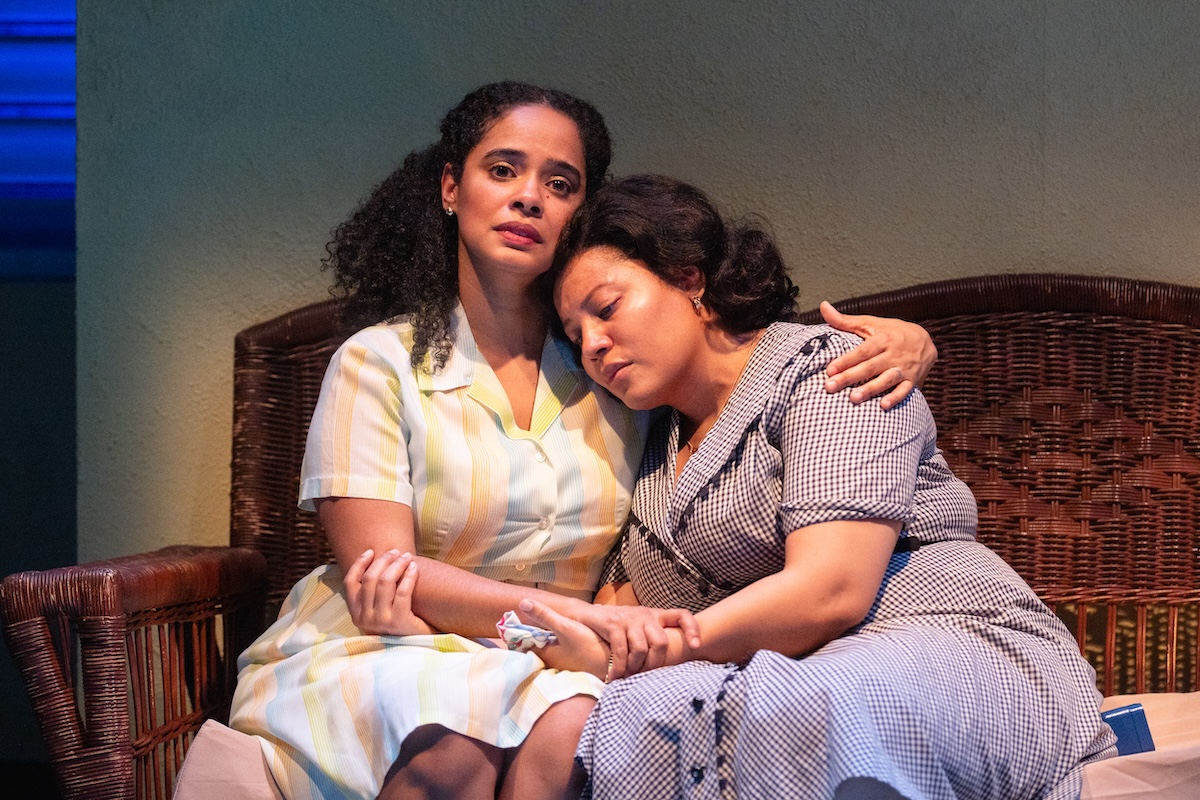Eschewing the Scenery

(Photo © Gerry Goodstein)
I love Ragtime — always have, always will. I still remember how excited I was when I first heard the concept recording in 1996. Two years later, I saw the show on Broadway at what was then called the Ford Center. I saw both the matinee and evening performances on January 17, 1998, the day before the official opening. It was one of the best days I’d ever spent at a theater or anywhere else.
Since then, I’ve since seen two other stagings, both of them modest reproductions of the original Broadway version. But the Paper Mill Playhouse’s Ragtime has almost none of the scenery found in the original. What’s more, Coalhouse Walker’s beloved Model T roadster isn’t on hand. We’ve all seen shows in which four chairs have represented a car, but here, director Stafford Arima doesn’t even go that far: Two chairs do the trick.
Well, they may do the trick for him, but not for me. In my review of the production for the Star-Ledger, I wrote that the musical itself is terrific and that this cast is marvelous for the most part, but that the show suffers for not having scenery and for lack of this important prop. A member of the Paper Mill board of trustees wrote to chide me for feeling this way, as did a 75-year-old female theatergoer. Both insisted that the absence of scenery made Ragtime a stronger theatrical experience because now we all could concentrate more fully on the material and the performances. “Actually,” wrote the theatergoer, “I found that the bare stage enhanced the power and the message of the musical.”
I don’t buy that at all. When Ragtime was running on Broadway, I did hear some people say that the show was overproduced, with that stereopticon above the action taking most of the heat for being unnecessary. (I didn’t agree.) But if there’s such a thing as overproduced, then there has to be by definition such a thing as underproduced — and that’s what I call the current production of Ragtime.
The contrast between Father and Mother’s house and the dens where the blacks play their music is important. There is a bitter irony with the desperate Coalhouse holed up in the ornate Morgan Library — when you see it. But more important still is that car. It’s Coalhouse’s pride and joy, a symbol to him that he’s making it in America and that this country works. There’s a reason that the song he sings, “Wheels of a Dream,” uses automotive imagery. His car is one of the prime reasons that the white hooligans are jealous of him; watching them hack away at the vehicle is a powerful image, and seeing the result of their destruction is heartbreaking. To see a chair tipped over is not the same thing. And by the way, when Ragtime was at the Ford, I never heard one single person complain, “I don’t know why they had to go and bring a car on stage!”
I can live with productions without scenery; I seldom if ever miss a Musicals in Mufti show at the York or anything at Encores! Both series offer next to nothing in scenic values, but their readings are advertised as such. To make an absence of scenery into a virtue and claim that a show is better because of it doesn’t wash with me. What I really hate is when someone says he’s doing a show “without the trappings of scenery.” Why are we “trapped” if we have handsome scenery to look at? Are we going to miss something because of it? I’ll grant you that when an audience is first shown a nice set — when the curtain rises or the lights come up on it — they may applaud or even go “oooh!” in admiration. But, after that, I truly believe they concentrate on the show. Why wouldn’t they?
Those people who believe that sets “trap” a production must be aghast at what happed at the Tonys this year: Twice as many awards for set design were given than ever before, in separate categories for plays and musicals. (Doesn’t the nominating committee know that a show is better off without sets? That must be why The Pillowman and The Light in the Piazza didn’t respectively win for Best Play and Best Musical; they were ruined by their Tony-winning sets! If only the producers had been smart enough to eliminate the “trappings,” they could have been on stage winning and spinning their Tonys on June 5.) Lope de Vega once said that all you need to make good theater is “three boards, two actors, and one passion.” Well, I went to my bookshelf and found a de Vega play called The Sheep Well: It has 23 characters, not including the “peasants and musicians” listed at the end of the dramatis personae. What’s more, the first scene takes place in a hall, the second in a Catholic Church, the third in the countryside, the fourth in a plaza — and that’s only the first act!
A few years ago, there was a production at another New Jersey theater of a one-person show that the theater’s executive producer had found at the Edinburgh Festival. There, he wrote in the program, it “was staged on a totally bare stage. [Italics his]. In bringing the play here, the temptation was to make it all more elaborate: a realistic set, fancier props, costumes, etc. But to do so would be to diminish the experience; for with this play, less is more.” Really? The play was set in a European train station in 1943, which could have been ornate or distressed, depending on how much havoc the war had already played with it. That could have made a potent statement about war and its aftermath. But, wrote the executive producer, “We want you to feel the thrill of being a full participant in a remarkable piece of theater by watching a talented performer who invites you, indeed compels you [italics again his], to employ every facet of your imagination.” Ah, imagination! If you need a set, then you don’t have enough imagination in you. It’s your fault! (Maybe the audience for that show didn’t think so; the theater is out-of-business now.)
I say those who tell us that a show is actually better “without the trappings” of scenery are trying to sell us a bill of goods. They want us to believe that we’re shallow and superficial for wanting such a bourgeois thing as scenery, and that if we were really people of substance, the words (and music) of a show would be enough. Let’s face it: It’s money, pure and simple, that keeps producers and regional theaters from offering sets. Sheer stinginess may not be the motive; a theater may simply not have enough funds in the coffers to spend on scenery, and a producer may not be able to raise it. But I’d prefer to hear a director or spokesperson say honestly, “Listen, we’re doing the best we can under very difficult financial circumstances” than to hear them malign scenery itself. If you claim to produce musicals, produce musicals — not glorified readings.
It all reminds me of Jean Kerr’s comment about a bare-bones show that she saw. Before the curtain, the director had bounded onto the stage and said that the audience should “bring something to this production.” Kerr remarked afterwards: “From now on, when a director asks me to ‘bring’ something to a production, I’ll bring a book.”
********************
[To contact Peter Filichia directly, e-mail him at pfilichia@theatermania.com]










